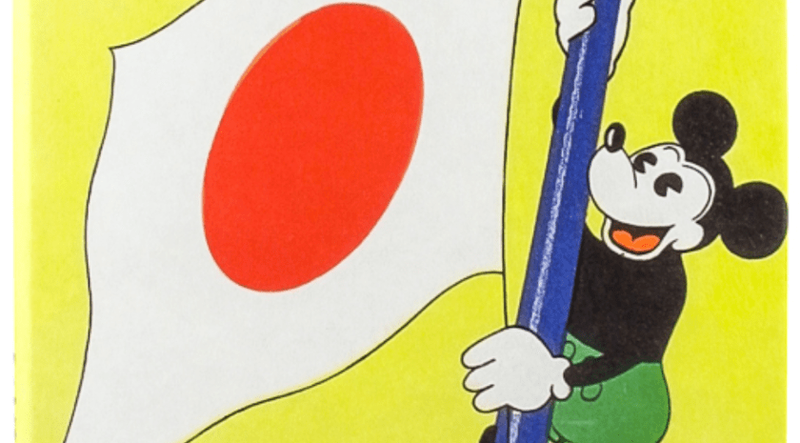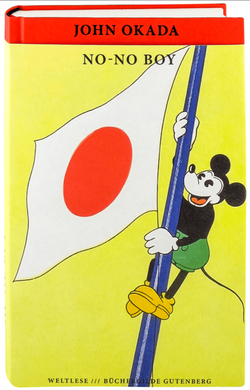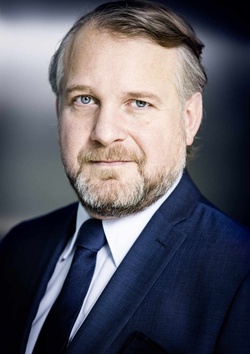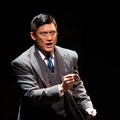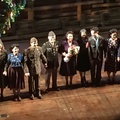Congratulations to author and cultural manager Thomas Girst for providing the literary and historical commentary appended to the new German translation of John Okada’s No-No Boy.
Girst is the author of the 2015 academic study, Art, Literature, and the Japanese American Internment: On John Okada’s “No-No Boy,” and he reveres Okada’s work as much as anyone. Girst’s fine epilogue provides the context of the WW2 incarceration experience for the German reader, and a close reading of Okada’s text.
The new edition is published by Büchergilde of Frankfurt under license from the University of Washington Press, and was translated into German by Susann Urban. Incidentally, the Okada family’s copyright is undisputed in all territories outside the U.S.
The book sports an eye-catching jacket design by Thomas Pradel, with an image of Mickey Mouse scaling a pole flying the flag of Japan. It’s reminiscent of the pop art of Roger Shimomura, and novelist Shawn Wong, for one, is not surprised. He observes that the cover to the German translation of his American Knees (with the title translated as With or Without Chopsticks), comes with an image of a bottle of Coke and chopsticks picking up French fries. Shawn will be pleased to know that the original CARP edition of No-No Boy is noted on the German edition page.
Girst graciously answered a few questions from us via email, and in it he nails the reason why the moral universe of John Okada’s novel is needed now more than ever here in the U.S. and in the European Union:
Resisters.com: What prompted the publisher to commission this new translation into German? Was it in response to interest generated by your own Okada study, or what? How can it be that there is interest in Germany in this novel by a Japanese American?
I wish I could take the credit for a German interest in John Okada’s novel yet that is surely not the case. My own study on Okada and Japanese American internment was only read by the very few, mostly within the confines of academia, though it generated some renewed interest in the context of Donald Trump’s proposed Muslim ban some two years ago.
The German writer Ilija Trojanow edits a series for the Büchergilde publishing house in which he has published over a dozen books of hidden classics, forgotten champions and unsung heroes of world literature. When Trojanow approached me to write an essay on John Okada’s No-No Boy for the German translation I was delighted that he had apparently stumbled across this gem and felt that it fits right into his publishing vision. It was about time this book is now available in German.
As for many countries across Europe, the little that is known about Japanese American internment is mostly thanks to David Guterson’s Snow Falling on Cedars and its film adaptation. Yet I would think that because of Germany’s own past, there is a certain sensibility when it comes to the plight of Japanese Americans in World War II. What I think is interesting that a review of the German edition of No-No Boy also reviewed some newly translated books and essays by James Baldwin. When the New York Times wrote about Okada in January of 1966, both authors were already put in context for the first time. I believe that to be a highly valuable comparison.
You write so well in English. How do you rate this translation of Okada into German? Any interesting issues of translation that you noticed? In Japan, for example, translator Ryusuke Kawai felt the previous Japanese translation used too many antiquated and obsolete terms.
Susann Urban is a renowned translator thanks to whom a German audience could read books by John Steinbeck or Percival Everett, among others. We were in touch on and off throughout her work on No-No Boy and she mentioned the oftentimes rough language of the original and the sometimes rather unusual imagery full of tenderness within. When I asked her about the challenges the book posed for her, she let me know that it wasn’t as easy as usual for her to find the specific rhythm of Okada’s language and saving the bulkiness of his sentences in their German translation. To her it was the most beautiful and gratifying to make Okada’s highly original rhythm resonate in another language.
I found her translation without any flaws and a review of No-No Boy in a major German daily praised her skills. I think she did a particularly great job in keeping Okada’s words and structure as raw and as immediate as they are in their original. It happens, sometimes automatically, as with the first German edition of Dostoevsky’s works for example, that a translation renders an author’s book more smoothly, more rounded and less edgy as its original. This is certainly not the case with Urban’s Okada.
For those who cannot read your Epilogue in German, what are the basic messages you convey to the German reader, beyond summarizing for them the Japanese American experience in wartime concentration camps? Given the long-past experience of mass extermination in Germany, how do the German people today regard the Japanese American experience? Has that changed over time?
The monstrosities of Nazi Germany, the unspeakable horrors and the genocide perpetrated by my forefathers only two generations removed from my own must not be watered down by comparing it with anything else. The Shoah is the past we have to confront and never forget. We must know about it, and teach our kids about it. With a sense of responsibility and the strong guiding principle of “never again”, anyone within Germany as a civic society must stand up against anti-Semitism, xenophobia and nationalism. We must read Primo Levi and Victor Klemperer, we must not take democracy for granted but cherish its principles and honor its foundations every day. Those foundations here in Germany are built upon the worst crimes imaginable. I would like to think that my generation is sensitive towards those issues.
The blurb of the German translation hails No-No Boy as “a highly relevant masterpiece”. With strongman politics and nationalism on the rise, with a surging far-right movement even in Germany, I would very much like to think that that John Okada’s book sadly remains rather topical in its subject matter.
The cover is certainly eye-catching, and wholly unexpected when we as Americans think of the No-No Boy, or the wartime incarceration. How do you interpret the artist’s intention in juxtaposing Mickey Mouse with a Japanese flag. Do you think the artist was at all influenced at all by the collages of Roger Shimomura, the pop art of an Andy Warhol, or what?
I was rather surprised by the cover and Shimomura, whom I write about in my PhD thesis, surely came to mind. I had initially suggested to the publisher to maybe make use of Okada’s initial cover, the strong visual of the head of a young Japanese man behind barbed wire created by M. Kuwata. If the German cover makes readers buy the book, why not? It surely is a captivating image. To me it does not have all too much to do with the content of the book, however. Micky Mouse climbing a flagpole and smiling at the Japanese flag does not make much sense of course.
Personally, I was happy to find the Japanese flag on the cover. As I have pointed out as part of my close reading of No-No Boy, its look is similar to that of the Lucky Strike logo, a symbolism Okada consciously toys with as part of a key scene involving Ichiro and his father during the night of Ichiro’s mother’s suicide. The cigarette brand’s motto “It’s toasted” gathers a whole new meaning when we put it into the context of the nuclear bombs that destroyed Hiroshima and Nagasaki.
What prompted your initial interest in John Okada as a novelist, an interest so strong that you wrote a book examining his work? Why do you feel it can be regarded as “world literature?”
I came across John Okada and No-No Boy during an “Emerging Literatures” course at the American Studies department at NYU in the spring term of 1996. Ichiro was about my age back then and I had just arrived in New York on a scholarship from Hamburg University. I was immediately taken aback by the voice, the urgency, the beauty, the horrors of this book. I actually tried to translate it but I did not get very far. In my prior work and even today I am very interested in the intersection of aesthetics and politics and I found that John Okada had mastered that challenge in literature like no one else I had read before.
Through my studies, I became more interested in Japanese American Literature and the particular historic situation during World War II. I was also frustrated that there was so little information on John Okada. I was used to reading big bios alongside my studies of Joyce, Proust, Mann, and Musil. Okada opened up a world to me and I felt very grateful for this. Which is also why I wanted to delve in deeper. My M.A. thesis evolved around his book while my PhD thesis also took into account the larger context of the internment camps and how art and literature come into being even in the most dire contexts of propaganda, censorship and manipulation – when even the basic material to create art is scarce or missing entirely.
I was able to speak with Dorothy Okada as well as John’s children. My book on him is dedicated to Frank Emi, who helped me a lot while doing research at the West Coast and in the archives of the Japanese American National Museum. I also met with Frank Chin and many former internees. Of course they were wondering what a white German man of my generation was researching their histories for. I felt very welcome and I still cherish the level of exchange I was able to establish as everyone went out of their way to assist with my inquiries.
As for John Okada and “world literature,” I am not the one to decide – yet with my background, I of course couldn’t help but draw many parallels to the writers I had read and studied previously. I was delighted to find out through my research that John Okada had studied much Western literature, mostly while at Teacher’s College in New York. Surely something that also informed his unique and amazing writing. What was important for me to show was how relevant Okada’s writing was, never to be severed from its specific historic context but greatly meaningful and valuable in both its content and beauty throughout many cultures.
*This article was originally published on Resisters.com on July 7, 2019.
© 2019 Frank Abe


